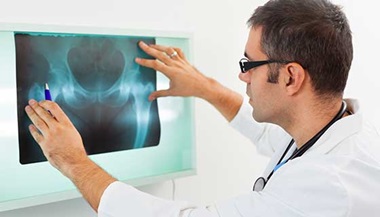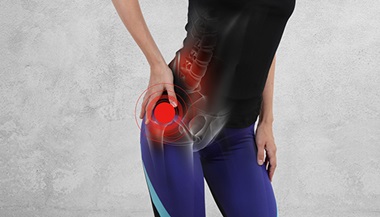Hip Fractures: Five Powerful Steps to Prevention
Every year, 350,000 hip fractures happen in the United States. For people over age 50, this split-second injury too often divides life into starkly different “before” and “after” phases. One in three people who lived independently before a hip fracture spend a year or more in a nursing home afterward. Forty percent of hip fracture sufferers are unable to walk independently a year later, and 60 percent can no longer take care of everyday necessities, like getting dressed.
.jpg?h=358&iar=0&mh=360&mw=520&w=520&hash=5423D41A56A81A0324968D519A127444)
Even more alarming: One in four adults who fracture a hip die within a year. “Older adults can have life-threatening complications during or after surgery to treat a hip fracture, such as blood clots, infections and heart arrhythmias ,” says Deborah Sellmeyer, M.D., medical director of the Johns Hopkins Metabolic Bone Center. “That’s why it’s important to do all you can to prevent fractures—especially hip fractures.”
Fortunately, experts are learning more all the time about the preventive steps you can take.
Take your risk seriously.
One in three women and one in five men will have a fracture at some point after age 50.
Screen—and maintain—bone strength.
Low bone density doubles or even triples hip fracture risk. That’s a major concern, because 56 percent of women and 18 percent of men age 50 and older have reduced bone mineral density, including the 16 percent of women and 2 percent of men with bone density low enough to be categorized as osteoporosis. Another 40 percent of women and 16 percent of men have osteopenia, a milder degree of low bone density.
Bone density tests are recommended for all women age 65 and older, and for younger women at higher-than-normal risk for a fracture. Discuss your individual risk for fracture and need for bone density testing with your doctor. Screening for problems with bone density scans resulted in a 36 percent lower fracture risk in one Johns Hopkins study. Screening for osteoporosis lets you and your doctor make decisions about treatments that keep bones strong and fracture-free, Sellmeyer says.
Men may want to discuss osteoporosis screening with their doctor if they’re over age 70 or at risk for thinning bones due to factors such as long-term use of corticosteroid drugs, like prednisone.
Keep muscles strong.
Nine out of 10 hip fractures are caused by falls. Exercises that maintain muscle strength, endurance and balance can lower your risk for the slips, trips and tumbles that break bones. In one study, women who had not exercised in a year were at higher risk for hip fracture, even if they did not have osteoporosis. A regular exercise routine can cut your risk of a fall by 20 percent to 30 percent, research has suggested.
Eat for a healthy frame.
Aim for 1,000 mg of calcium daily for women before age 50 and men before age 70, then 1,200 mg for women over age 50 and men over age 70. “You also need vitamin D to help absorb calcium. The current recommendations are 600 IU per day up to age 70 and 800 IU after age 70,” Sellmeyer notes. “There’s no doubt that this combination reduces fracture risk.”
But don’t stop there. Get plenty of potassium-rich fruits and vegetables daily; in a 2013 study, Sellmeyer and colleagues found that this mineral had a positive effect on calcium metabolism. And don’t skimp on protein, which seems to help by maintaining muscle mass (important for strength) and by helping build bones.
Check your eyes and your medicines.
If you feel drowsy, dizzy, weak or off-balance when walking, ask your doctor for a medication check. Some prescription drugs can cause these fall-inducing side effects. “And stay up-to-date with vision checks and eyeglass prescriptions,” Sellmeyer says. “Sharp vision can also help you avoid a fall.”
Try It Fall-Proof Your Home -- and Your Shoes
Most falls happen at home, but easy changes could reduce your risk of a tumble by 61 percent.
- Keep floors and stairs clutter-free.
- Remove throw rugs.
- Use nonslip mats in the tub and on the bathroom floor.
- Add grab bars in the tub or shower and handrails on stairs.
- Improve lighting.
- Wear well-fitting shoes, even around the house. Wearing high heels or shoes with extremely thick rubber soles, and going barefoot (or walking around in your socks) at home may boost risk.
Definitions
Arrhythmias (a-rith-me-ahs): Problems with the heart’s electrical system that can make heart beats speed up, slow down or not follow a regular rhythm. One common arrhythmia, called atrial fibrillation, triggers rapid, irregular heartbeats that can increase risk for a stroke or heart failure. Doctors use heart monitors and other tests to diagnose arrhythmias, which can be treated with medicine or if needed, surgery.
Bone density: The amount of calcium and other minerals inside a section of bone. Strong bones contain a dense framework of protein strands coated with calcium. This support system thins with age, lack of exercise and low intake of calcium and vitamin D, among other reasons. Low bone density increases fracture risk.
Muscle mass: Your muscles contract to power movements, and their mass refers to their size. The greater your muscle mass, the larger and denser your muscles are. The related term lean body mass is the weight of your muscles, bones, ligaments, tendons and internal organs.





